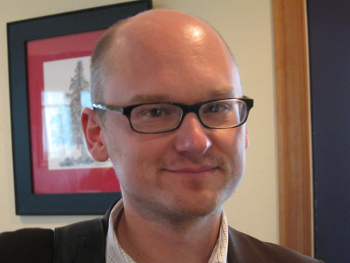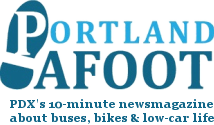What does it take to be an entrepreneurial journalist?
Freelance writers already possess many of necessary attributes, including an drive to be their own boss and willingness to jump into the non-writing aspects of the journalism business, including marketing and collections.

But spurred by the economy, hard times in traditional media and a wealth of cheap online publishing technology, some writers are taking self-employment one step further and started publications – not just hyperlocal news sites or blogs (though many use blogging software) but fully realized newspapers and magazines.
One of them is Michael Andersen, a Portland, Oregon, journalist and publisher of Portland Afoot, a print and online publication about the city’s buses, bikes and “low-car life.” The monthly print edition – Andersen calls it a “10-minute newsmagazine and wiki” – is currently available free to anyone who works in North Portland or downtown.
Andersen took a couple minutes off from his busy schedule recently to answer a few questions from WordCount about the trials and tribulations of starting a publication, hyperlocal news, and his favorite Portland bus line and walking route.
If you like what you read, stick around to the end of the post and find out how you can receive Portland Afoot for only $10 a year.
 WordCount: How’d you come up with the idea for Portland Afoot?
WordCount: How’d you come up with the idea for Portland Afoot?
MA: I was covering local government for a suburban daily newspaper and cranking out all these 700-word stories that were monkey screech to anyone who hadn’t been following local government news. I don’t know anyone who reads local government news every day except local government employees. Portland Afoot is designed to deliver one niche of government news (public transit) to one group of people who care about it (transit riders) in a quantity they can handle (10 minutes a month, with searchable evergreen information on demand).
WC: How is running a publication different from being a freelance journalist?
MA: I’ve only freelanced since I started Portland Afoot — it’s a way to keep the cash flowing — so it’s hard to say. Compared to local newspaper work, there’s a vast difference in the chance that someone will return my call. I now assume that 4 in 5 cold calls won’t get returned. At a newspaper I could bat .500 if I played my cards right.
WC: Do you have staff, and if so, what do you pay?
MA: It’s a nonprofit, so I report to a five-person volunteer board, and we’ve had a handful of other amazingly supportive volunteers. That’s it so far. I hired Rebecca Robinson, a friend and statehouse reporter, to do one 300-word interview with Rep. Jeff Smith. She got $30 and a batch of brownies.
WC: What’s been your biggest challenge so far?
MA: Budgeting my time. Having lots of things you can always do means that you’re constantly tempted to do the fun things. It’s very important to do the not-fun things, like convince people to give you money. That’s why people who do that get paid more than reporters.
WC: What have you learned about yourself?
MA: My flaws — distractability, shyness, thin skin, procrastination — didn’t magically go away. If I succeed despite them, it’ll be because of strengths I didn’t have, and couldn’t have built, while working at a larger company.
WC: AOL is hiring Patch editors all over the country, but Allbriton just pulled the plug on TBD, a high-profile news site covering suburban Washington D.C. What does that say about the future of hyperlocal news: will it last, and is there still a place for solo entrepeneur like yourself?
MA: I didn’t have time to check out TBD, so I don’t know what their content was like. I respect every local-news experiment, including AOL’s. But the key is brand depth. Here in Portland we’re lucky to have one of the country’s best and most successful local-news startups, BikePortland.org. I think Jonathan (Maus) would tell you the #1 key to his success has been brand-building. It’s taken him five years, but it’s his deep, hard-earned relationship with readers — not his pageviews, though they’re substantial — that earns premium prices from his advertisers.
WC: Your favorite TriMet bus line?
MA: The 85-Swan Island. Three reasons. (1) It feeds this industrial area where everybody works extremely regular shifts, meaning that there’s this iron-like camaraderie that you can feel when you get on. (2) The line was more or less singlehandedly created and protected by my friend Lenny Anderson. (3) Every month, we run a funny “Only on the Bus” story on our back cover. I’ve been sitting on one about the 85, told by local bus-driver celebrity Dan Christensen, until next summer. It’s that good.
WC: Best metro area hike?
MA: My favorite so far is Rocky Butte, which I visited on a trip with local hiking writer Laura Foster as part of the City of Portland’s Ten-Toe Express urban walking series last year. I’m going back with a young lady this Saturday, actually. I think my first book is going to have to be about car-free dating.
WC: Words of wisdom for entrepreneurial journalists who aspire to do their own thing?
MA: Portland-born phrase here: Just do it.
***
Live in Portland, or just love the city? The first 5 WordCount readers who act can subscribe to Portland Afoot for just $10 a year with coupon code “WordCount.”
I’d never thought about starting a publication of my own, but it’s a brilliant idea. This piece also makes me think about something a woman I work with here mentioned, and that’s the idea that people will eventually begin wanting something they can hold in their hands. The virtual experience – reading things on the web for free – is all well and good, but eventually we’ll want something special (that we perhaps subscribe to) and something tangible (a magazine or newspaper we can hold in our hands).
Joan, it’s great that you like the idea of a personal publication and I’m proud to have gotten your juices going. I think that creating a small print product around your area of writerly expertise is an excellent way to brand yourself.
Two notes of caution:
1) The print product is a colossal hassle. Layout software, finding a printer, folding, addressing — to say nothing of the hassle of paying for it. My costs are about $10 per year per subscriber (so we’ll basically break even on the subscriptions offered above), but that’s only because we’ve gotten to several hundred subscribers. Not losing money on the print production required me to get a lot of volume quickly, and that’s difficult. There are workarounds — we use metal plates, an offset press and high-quality paper, all of which we could have done without — but people have a gut reaction to print products that correlates powerfully with production quality.
2) I question your colleague’s prediction that people will eventually feel a need to return to print. This experience has confirmed for me that print is extremely powerful to the reader’s experience, but that doesn’t erase the numerous advantages of digital distribution — no marginal costs, open-and-shut production, easy interaction and linking from other sites. It’s not that paper is getting worse or less desirable — indeed, as it continues to get rarer, I think the novelty of it will be a slightly stronger asset — but digital products are improving so fast that I don’t expect paper to make sense for Portland Afoot for more than a few years.
I could be wrong.
If anyone reading this would like some details, financial and otherwise, about the costs of starting a similar publication, I’m always happy to share them. michael@portlandafoot.org.
Michael, thank you again for being so generous with your time, information and willingness to share.
Michelle